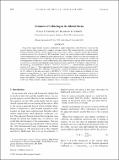Estimates of Cabbeling in the Global Ocean
Author(s)
Schmitt, Raymond W.; Schanze, Julian Johannes
DownloadSchanze-2013-Estimates of Cabbeli.pdf (1.870Mb)
PUBLISHER_POLICY
Publisher Policy
Article is made available in accordance with the publisher's policy and may be subject to US copyright law. Please refer to the publisher's site for terms of use.
Terms of use
Metadata
Show full item recordAbstract
Owing to the larger thermal expansion coefficient at higher temperatures, more buoyancy is put into the ocean by heating than is removed by cooling at low temperatures. The authors show that, even with globally balanced thermal and haline surface forcing at the ocean surface, there is a negative density flux and hence a positive buoyancy flux. As shown by McDougall and Garrett, this must be compensated by interior densification on mixing due to the nonlinearity of the equation of state (cabbeling). Three issues that arise from this are addressed: the estimation of the annual input of density forcing, the effects of the seasonal cycle, and the total cabbeling potential of the ocean upon complete mixing. The annual expansion through surface density forcing in a steady-state ocean driven by balanced evaporation–precipitation–runoff (E–P–R) and net radiative budget at the surface Q[subscript net] is estimated as 74 000 m[superscript 3] s[superscript −1] (0.07 Sv; 1 Sv ≡ 10[superscript 6] m[superscript 3] s[superscript −1]), which would be equivalent to a sea level rise of 6.3 mm yr[superscript −1]. This is equivalent to approximately 3 times the estimated rate of sea level rise or 450% of the average Mississippi River discharge. When seasonal variations are included, this density forcing increases by 35% relative to the time-mean case to 101 000 m[super script 3] s[superscript −1] (0.1 Sv). Likely bounds are established on these numbers by using different Q[subscript net] and E–P–R datasets and the estimates are found to be robust to a factor of ~2. These values compare well with the cabbeling-induced contraction inferred from independent thermal dissipation rate estimates. The potential sea level decrease upon complete vertical mixing of the ocean is estimated as 230 mm. When horizontal mixing is included, the sea level drop is estimated as 300 mm.
Date issued
2013-04Department
Woods Hole Oceanographic InstitutionJournal
Journal of Physical Oceanography
Publisher
American Meteorological Society
Citation
Schanze, Julian J., and Raymond W. Schmitt. “Estimates of Cabbeling in the Global Ocean.” Journal of Physical Oceanography 43, no. 4 (April 2013): 698-705. © 2013 American Meteorological Society
Version: Final published version
ISSN
0022-3670
1520-0485